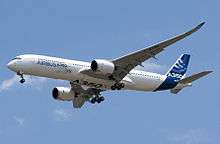Maiden flight
The maiden flight of an aircraft is the first occasion on which an aircraft leaves the ground under its own power. This is similar to a ship's maiden voyage.
The first flight of a new aircraft type is always a historic occasion for the type. In the early days of aviation it could be dangerous, because the exact handling characteristics of the aircraft were generally unknown. The first flight of a new type is almost invariably flown by a highly experienced test pilot. First flights are usually accompanied by a chase plane, to verify items like altitude, airspeed, and general airworthiness.
A first flight is only one stage in the development of an aircraft type. Unless the type is a pure research aircraft (such as the X-15), the aircraft must be tested extensively to ensure that it delivers the desired performance with an acceptable margin of safety. In the case of civilian aircraft, a new type must be certified by a governing agency (such as the Federal Aviation Administration in the United States) before it can enter operation.
Notable first flights



An incomplete list of first flights of notable aircraft types, organized by date, follows.
- June, 1875 – Thomas Moy's Aerial Steamer, London, England (pilotless, tethered)[1]
- October 9, 1890 – Clément Ader – took off from Gretz-Armainvilliers, Ouest of Paris, France
- August 14, 1901 – Gustave Whitehead From Leutershausen, Bavaria
- May 15, 1902 – Lyman Gilmore – took off from Grass Valley, California
- March 31, 1903 – Richard Pearse – took off from Waitohi Flat, Temuka, South Island, New Zealand
- December 17, 1903 – Wright brothers Wright Flyer – first heavier-than-air powered aircraft
- March 18, 1906 – Traian Vuia, a Romanian engineer, flew in Montesson near Paris, France.
- October 23, 1906 – Alberto Santos-Dumont 14-bis flight, in Bagatelle park, Paris, France
- July 4, 1908 - Glenn Curtiss flew the first pre-announced public flight of a heavier-than-air flying machine. He flew 5,080 feet, to win the Scientific American Trophy and its $2,500 purse.
- July 28, 1935 – Boeing B-17 Flying Fortress – World War II American heavy bomber.
- December 17, 1935 – Douglas DC-3 – propeller-driven passenger and cargo aircraft of which more than 10,000 were produced
- December 29, 1939 – Consolidated B-24 – World War II American heavy bomber.
- November 2, 1947 – Hughes H-4 Hercules – only flight of this oversized flying boat.
- July 27, 1949 – de Havilland Comet – first jet airliner.
- August 23, 1954 – Lockheed C-130 Hercules – military transport plane.
- May 27, 1955 – Sud Aviation Caravelle – first jet airliner with engines mounted in the tail.
- April 25, 1962 – Lockheed A-12 Blackbird – supersonic reconnaissance plane.
- June 29, 1962 – Vickers VC10 – first airliner with 4 engines mounted in the tail.
- April 9, 1967 – Boeing 737 – short-to-medium-range airliner.
- October 4, 1968 – Tupolev 154 – Soviet/Russian airliner, still in operation.
- December 31, 1968 – Tupolev Tu-144 – Soviet supersonic airliner.
- February 9, 1969 – Boeing 747 – first widebody airliner.
- March 2, 1969 – Anglo-French Concorde – supersonic airliner.
- September 19, 1969 – Mil Mi-24 – Russian/Soviet-made helicopter used by many countries to this day.
- October 28, 1972 – Airbus A300 – first Airbus aircraft, short- to medium-range wide-body jet airliner.
- February 22, 1987 – Airbus A320 airliner – first civil aircraft to have an all-digital fly-by-wire system.
- December 21, 1988 – Antonov An-225 Mriya – jet with the longest fuselage and wingspan and overall heaviest aircraft.
- June 12, 1994 – Boeing 777 – long-range airliner with the most powerful jet engines ever made.
- April 27, 2005 – Airbus A380 – doubledecker jetairliner, currently largest capacity in the world, took off from Toulouse–Blagnac Airport.
- December 11, 2009 – Airbus A400M – military cargo plane, Airbus first propeller plane.
- December 15, 2009 – Boeing 787 Dreamliner – first major widebody airliner to use non-metal composite materials for most of its construction.
- November 11, 2015 - Mitsubishi Regional Jet - Japanese Twin-engine Regional jet, the first designed and built in Japan of twin-engine Regional jet, took off from Mitsubishi Heavy Industries.
See also
References
| Wikimedia Commons has media related to Maiden flights. |
- ↑ Gary Bradshaw. "Thomas Moy's Aerial Steamer, 1874. lifted six inches (15 centimeters) off the ground.". U.S. Centennial of Flight. Retrieved 2016-02-18.